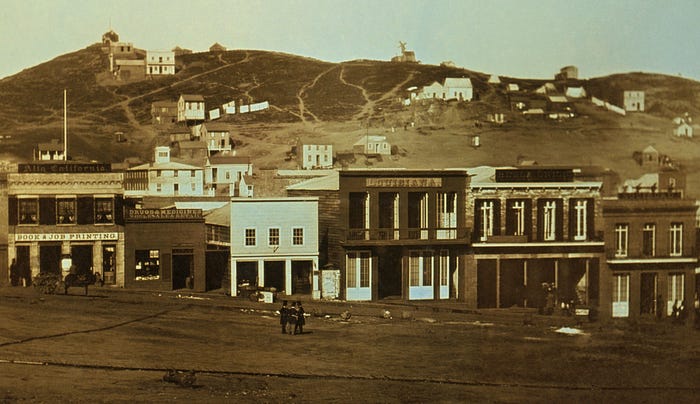Where does the Silicon Valley Entrepreneurial Mindset comes from?

This is the Chapter 4 of my e-book Silicon Valley for Foreigners, that can be downloaded for free on www.siliconvalleybook.com or purchased for $2.99 on the iBookStore and Kindle. A new chapter will be posted on this blog every week.
========================================
Before taking you to Silicon Valley’s psyche and well-guarded secrets, it is important to understand why this place has a unique and dynamic entrepreneurial mindset even if compared to other parts of California.
In the early 19th century, the United States was an overwhelmingly rural society. The American Dream, as most then understood it, was not centered in winning fabulous wealth, but rather to achieve the independence that came from owning enough land to support a large family. Enterprise and speculation were not the desired traits of the time.
In 1848, San Francisco was like many other ordinary American settlements: backward, agrarian and home of just a thousand residents. In the same year, however, the city literally struck gold starting a movement named “The Gold Rush” that would forever transform the settlement into a bustling metropolis full of opportunities.
By 1852, San Francisco had attracted more than 30 thousand adventurers and treasure seekers in search of the second iteration of the American Dream. The super competitive landscape made just a few lucky winners while the majority of people didn’t find any gold.
Along the immigrants, the first wave of what we define as modern entrepreneurs arrived in San Francisco. These were savvy businessmen who understood very early on that most immigrants would need basic services in order to survive in town.
People such as Vermont native Henry Wells and New Yorker William G. Fargo, who started a bank to provide express and banking services to California residents, specifically to people around the Bay Area. The bank was named Wells Fargo and made its founders very rich. It would become a huge enterprise that resisted the test of time. As of May 2017, Wells Fargo is the second largest bank in the world by market capitalization.
Another famous immigrant was Levi Strauss, who came from Bavaria in 1853 to open a west coast branch of his brothers’ New York dry goods business — clothing, bedding, combs, purses, handkerchiefs. He made a lot of money in San Francisco and some decades later his company invented the Jeans and created their first pair of Levi’s 501, a style that went on to become the world’s bestselling item of clothing.
Phillip Armour, who would later found a meatpacking empire in Chicago, made a fortune operating the sluices that controlled the flow of water into the rivers being mined. Before John Studebaker built one of America’s great automobile fortunes, he manufactured wheelbarrows for Gold Rush miners.
As you may have noticed already, one very direct consequence of the gold rush was the creation of some of the largest and most important companies of the pre-industrial United States. Companies that were not inherited but created from scratch like the many tech colossi of today’s Silicon Valley.
The gold rush also allowed a huge influx of immigrants from all corners of the world and walks of life. Immigrants that literally risked their lives to pursue their dreams and who brought a diversity of backgrounds, ideas, points of view, hopes and skills. Exactly like their modern counterparts.
This quick glance of history is important to understand the origins of entrepreneurship in this region. All this diversity and risk prone immigrants created a culture focused on optimism, ambition, and execution. A culture that spontaneously grew based on these values and allowed many to create companies from scratch without lots of resources or political connections. A culture of risk taking anchored by long-term vision that shaped the modern Silicon Valley.
Silicon Valley was born through several contributing factors intersecting, including a skilled STEM research base housed in area universities, plentiful venture capital, and steady U.S. Department of Defense spending. Stanford University leadership was especially important in the Valley’s early development. Together these elements formed the basis of its growth and success.
The world’s first technology startup, Hewlett Packard, started in a garage in Palo Alto, in 1939, founded by two engineers from Stanford University and a capital of US$ 538. HP rose to prominence in the 1950s and became the role model for all future entrepreneurs and startups of the 1960s and 1970s. HP is recognized as the symbolic founder of Silicon Valley.